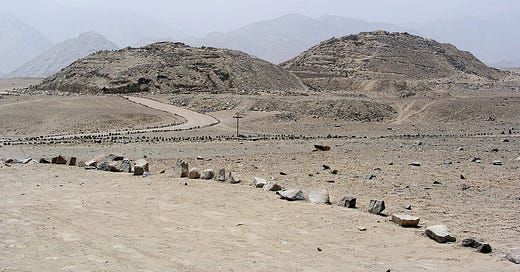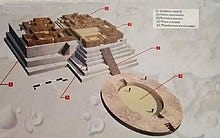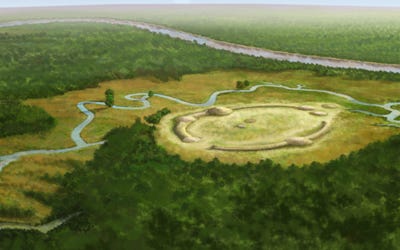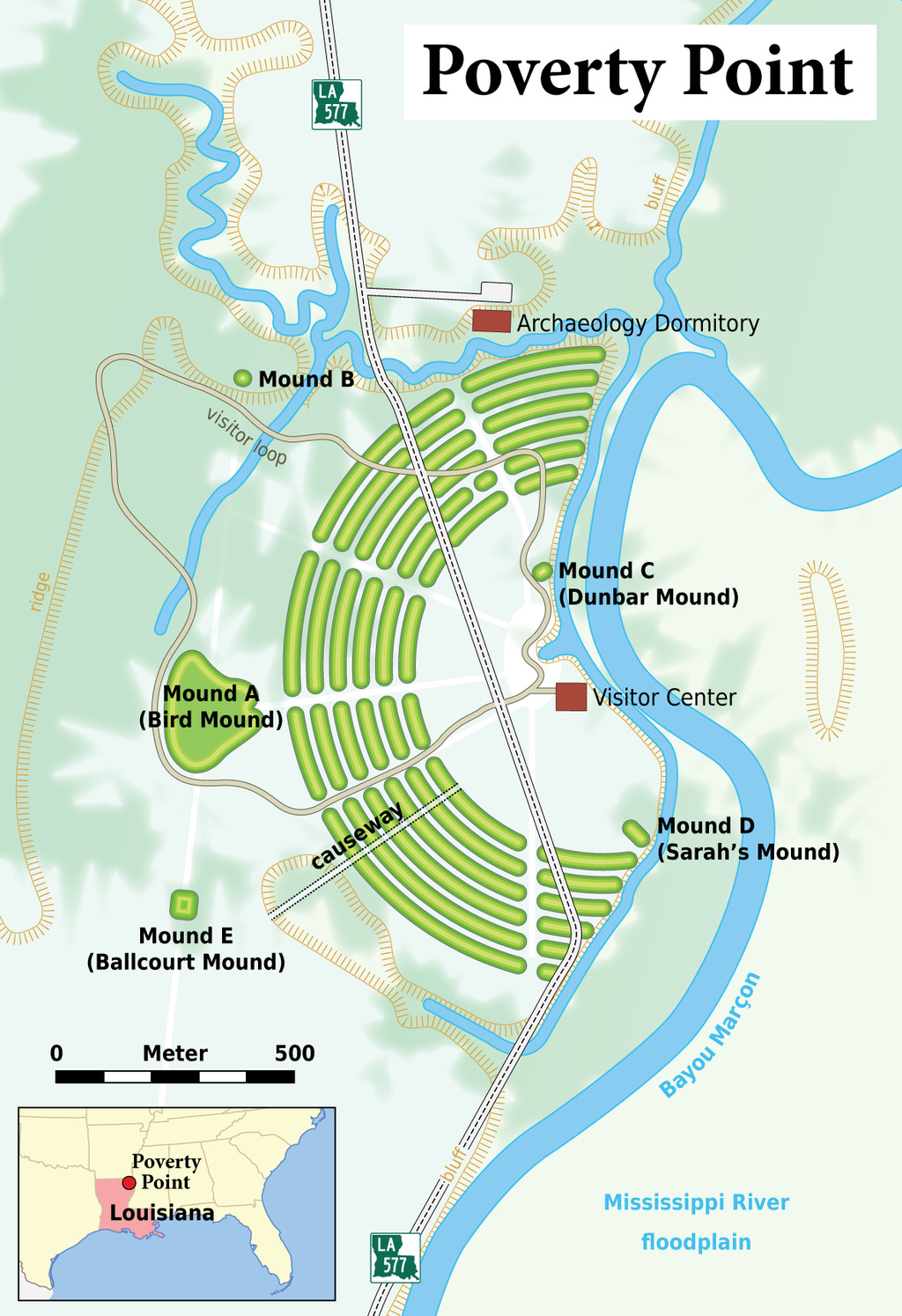Many thousands of years before the Inca built their empire along the spine of the Andes and long before the first Maya city took shape in Mesoamerica, the first complex societies emerged in the Americas.
All human societies are complex things. They’re constantly evolving in real time through the daily decisions of their participants, but they’re also timeless, passed down generation after generation and inculcated through childhood and a whole variety of cultural pressures and incentives. But some societies are more complex than others. Used in this sense, “complex society” is a technical term rather than a value judgement, referring to a human group that has crossed a series of thresholds:
1) Craft specialization. The items people use - stone tools, pottery, jewelry, fishing nets, boats, or what have you - reach a level of sophistication where they have to be made by people who have advanced and specialized knowledge of the craft. If they’re doing that specialized craft, they’re not acquiring food for themselves, so somebody else must be doing it for them, then exchanging that food for their special product.
2) Social hierarchies. Some people have more resources than others, which show up through bigger dwellings, more elaborate burials, or a pattern of better health outcomes relative to the rest of the population.
3) Settlement hierarchies. Some settlements are bigger than others, performing different and higher-level functions within a network of places where members of a society live and work. If you see a bunch of small farming villages and then a walled fort where people go to pay homage to a chief, or a ritual site where priests worship the gods, that’s a settlement hierarchy.
4) Monumental architecture. Big buildings like temples - really, large-scale construction projects of any kind - speak to the ability to concentrate and direct large amounts of labor.
In the traditional formulation, scholars treated these things like a checklist or a progression, where societies moved from simple to complex, picking up things like agriculture and political elites along the way. At the end of that road lay full-blown civilization, with cities, state structures, elites, and the written word.
As it turns out, though, there are no linear progressions or neat packages. Seasonally mobile hunter-gatherers can build monumental architecture, like Göbekli Tepe in what’s now Turkey. Apparently egalitarian societies, like the Neolithic farmers of Old Europe, might build huge and sprawling settlements like the mega-sites of the Cucuteni-Trypillia culture.
The Americas produced a whole series of these winding paths to social complexity. By 3700 BC, when the first cities and temples were cropping up in distant Mesopotamia and Neolithic Europeans were building enormous stone megaliths, the most intriguing place on the planet might actually have been the arid Norte Chico region of what’s now Peru.
At first glance, it’s not a promising place for a populous and complex society. The Norte Chico region is dry, exceptionally so. But three rivers flow down from the Andes toward the ocean, and along their banks, agriculture is viable and productive. Just offshore, the Pacific is incredibly productive, featuring some of the richest fishing grounds in the world thanks to the Humboldt Current. Put together, these were the ingredients for the precociously advanced societies of the Norte Chico.
Caral is the best known of the Norte Chico sites, a city that may have held several thousand people at its peak. The monumental architecture is striking, the remains of pyramids and buildings still jutting above the desert floor. Long stairways led up stepped platforms, built from layer after layer after layer of rock-filled reed or cotton bags called shicra. Circular plazas down below provided gathering places for the populace, though the precise purpose remains unknown to us.
There were as many as seventeen sites like Caral spread throughout the Norte Chico at the civilization’s peak. Some of them were built slowly, others rapidly. All depended on a variety of resources for survival, including maize, sweet potatoes, chili peppers, and of course the bounty of the nearby sea. These places lasted for a long time, thousands of years, and may have provided sets of traditions for future civilizations in the Andes that lasted until the arrival of Europeans.
In some ways, the Norte Chico followed the stereotypical pattern of complex societies; they had agriculture, monumental architecture, craft specialization, and cities. There were presumably social hierarchies, though perhaps more religious than political. Yet there was no sign of coerced labor to build these magnificent plazas and pyramids. Precisely why they were built, and how these societies functioned, is lost to us.
At roughly the same time as the people of the Norte Chico were building their cities, people in the southeastern United States were producing monuments of their own: mounds. Watson Brake, in northeastern Louisiana, is one of the earliest large mound complexes known, a prototype for many others found throughout the region over the subsequent millennia.
People lived at Watson Brake, but probably not on a permanent basis. There’s no sign of farming or elaborate social hierarchies, much less urbanism or even craft specialization. Yet the people who lived there over the course of centuries built a whole series of earthworks, extending in a rough circle, that stood as much as 30 feet high.
We have no idea why these people built the mounds at Watson Brake. They were local people, who used local resources, never ones imported over long distances. As far as we know, they cultivated no crops and kept no domesticated animals. Yet they built and lived among these massive earthen constructions for centuries.
Later mound complexes, like the nearby Poverty Point (dating to around 1500 BC) were even more elaborate:
The largest mound on the site, Mound A, stands more than 70 feet high and spans 700x600 feet at the base. It’s enormous, and it’s just one of a staggering series of earthworks that include artificial mounds, ridges, and causeways. Unlike the people of Watson Brake, the inhabitants of Poverty Point were quite cosmopolitan. They imported copper from the Great Lakes and stone from various sources along the upper Mississippi, and exported their own crafts everywhere within a hundred miles.
Unlike the people of Norte Chico, the inhabitants of Poverty Point weren’t farmers. They fished and hunted and gathered wild foods, enough to sustain the several thousand people who lived and worked on the mounds, but never grew their own.
Complex societies come in all shapes and sizes. There were more throughout the Americas, many more, a mosaic of possibilities spanning two continents and thousands of years.
Norte Chico and the mounds of the American southeast are two of the topics I cover in today’s episode of Tides of History.









I grew up in Ohio, and in high school had a friend from Chillicothe, a small, rural city which is surrounded by several ancient mound sites; I was amazed that we weren't taught this history in grade school. In the US we often come to know about Mesoamerican monumental pyramids of the Maya and Aztecs, but there's not nearly as much awareness of the moundbuilding civilizations whose ceremonial precincts can still be found across a huge part of the United States.
I just started reading "Florida's Indians from Ancient Times to the Present" by Jerald Milanich, which begins with several chapters of the state's precolonial societies. He suggests a progression from the shell middens—huge piles of shellfish refuse, essentially garbage heaps, many of which remain across the state today—which eventually became ceremonial mounds, elite burial sites containing copper artworks and other precious artifacts, and/or elevated platforms for religious rites.
I visited Poverty Point, and you get a feeling there. Nothing mystical, but it’s quiet and a little remote, and peaceful if you climb up the mound.